Pick and Roll Glossary
Page 1 of 1
 Pick and Roll Glossary
Pick and Roll Glossary
http://www.celticshub.com/2017/09/07/celticshub-whiteboard-pick-roll-glossary/
THE CELTICSHUB WHITEBOARD: PICK AND ROLL GLOSSARY
By Ryan Mahanna
On September 7, 2017
The Whiteboard is back after a short hiatus (there has been some actual Celtics news over the past few weeks, ICYMI) and we are ready to talk some basketball. If this is your first peek at The Whiteboard, welcome! We are here to help fans understand the game a little bit better and feel more informed when they are watching their favorite team, which of course is the Celtics.
Today’s topic is the pick and roll, a staple of the game’s past and present and a bedrock of basketball. Although it may seem like NBA teams run a pick and roll (we’ll call is PNR for short) every time down the floor, according to Synergy Sports, PNRs only make up about 17% of plays. The Celtics fall below that average (the Warriors are the lowest, which makes you really think) but it’s still a play that casual fans should be familiar with and, although it might be the simplest play in sports, it has its own unique language.
Below are some of the buzz words and phrases that you may hear during a NBA telecast. Hopefully these definitions and GIFs help prepare you for the upcoming season and at the very least help you to sound smarter than your friends.
Defense
“Help the Helper”
This term has a literal meaning, help your teammate who is helping someone else. Nothing kills a team defense like not helping the helper. Because guess what? The helper stops helping. He’s not going to leave his man to help you if he thinks no one else has his back. This is more of a general defensive term but it’s key to defending pick and rolls. Here is Kawhi Leonard stepping in and helping the helper.
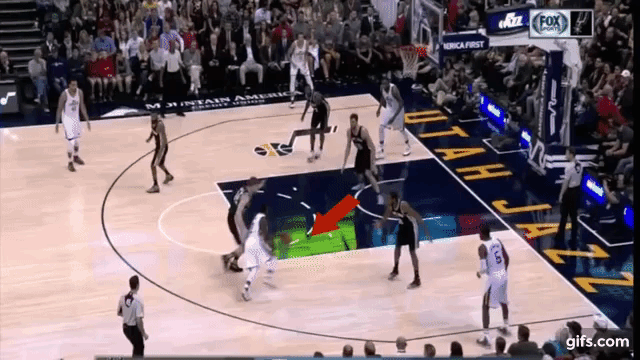
“Hedging” or “Showing”
These terms are basically interchangeable. The secondary defender (i.e. the man guarding the screener) will position himself up to the level of the ball so he can step out and impede the progress of the ball handler. The hope is that the hedging defender can cut off the direct driving line and give his teammate time to recover. Once the primary defender has recovered to his man, the secondary defender hustles to recover back to his. Celtics fans should be familiar with this action from the KG era.
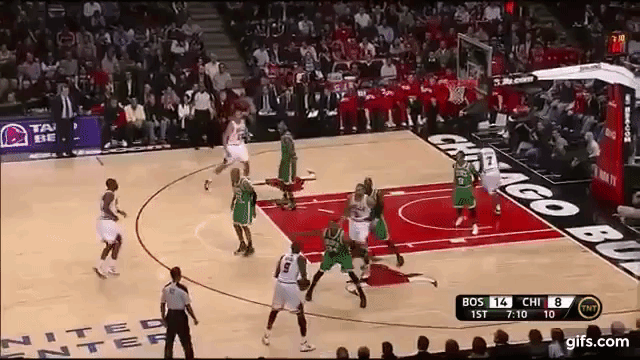
That was a basic one-step hedge and recover; a “soft” hedge. When the second defender takes two or three steps out to impede the ball handler, that is a “hard” hedge. In this case the man defending the screener is taking on a more agressive roll in chasing the ball handler off the direct path to the rim.

In both instances, you are asking the man defending the screener to be a good communicator, agile and well conditioned. Since those aren’t attributes that you’d typically associate with a big man, this type of pick and roll defense can be tricky. The entire 5-man defensive unit has to be working together.
“Blitzing” or “Jumping”
These terms are the extreme cousins of hedge/show. These are essentially fancy terms for trapping a PNR. Both defenders sell out and try to get the ball handler to pick up his dribble and make a bad decision. This is an effective technique late in the shot clock or if you simply want to get the ball out of a particular player’s hands.
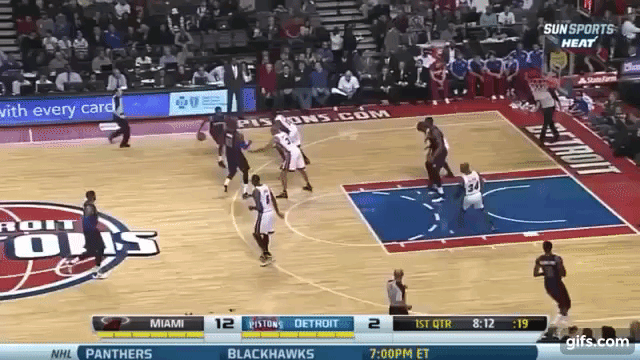
“Ice”
Icing a ball screen is modern technique that has an awesome name but is actually very simple. Icing’s patron saint is Tom Thibodeau and the simplicity is part of the genius.
After orchestrating a decade’s worth of elaborate hedge/help/recover defensive schemes, Thibs decided to boil things down to some basics:
1. Don’t let the ball get to the middle of the court
2. Force the ball handler to take a mid-range shot
2. Avoid having to help, and the chaos that follows
If you’re not going to help, that means you have to defend the ball screen two on two. The easiest way to defend a PNR is to prevent the screen from happening in the first place.
To do that, the on-ball defender angles his body so his man has no choice but to go away from the screen. Dribbling off the screen is no longer a option, but by doing that you are creating a wide open driving lane. The on-ball defender is pushing the ball handler into the midrange and along the sideline. The player defending the screener drops back to protect the paint.
A GIF is worth a 1000 words:

Notice how Batum angles his body to push the ball down the sideline and Lopez drops to protect the rim, classic ICE! This coverage keeps big men in their comfort zones, creates a one-branch decision tree for the ball handler, and prevents rotation breakdowns. Icing would be incredible at the lower levels of the game. If you coach a J.V. basketball team, put it in and tweet me updates.
Offense
“Pocket Pass”
Such a good name! The pocket pass is a type of pass that is commonly used in a PNR to hit the roll man in a tight window before the defense can recover. The pass is delivered on the bounce and originates from the ball handlers waist/hip area, therefore the “pocket.” Here is the master, Steve Nash, in action.
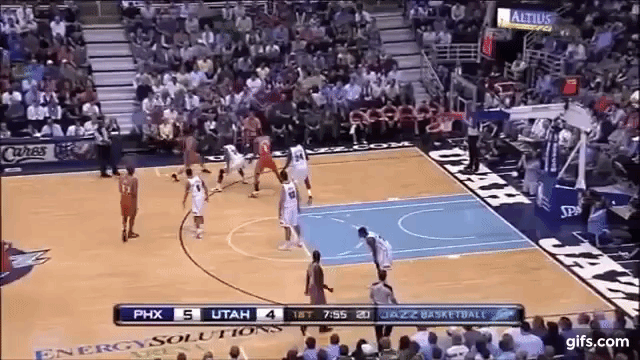
“Slip” or “Slide”
Slipping is an action that a screener can take to keep the defense on it’s toes. It is essentially a fake screen. The screen setter is using change of pace and change of direction to “slip” free.
The key is to approach the ball handler as if you were going to set a traditional screen. Your feet should be set and you should have no body movement. The moment you get the defense to settle into a plan, the screener will quickly move away from the ball and look for open space. The screen is actually never set and the hope is to catch the defense flat-footed or ready to begin a pre-planned coverage.
There is no wrong way to slip a screen and it’s very effective against switching defenses. You can slip for a jump shot, which is sometimes referred to as a “slide.”

Or slip to the rim, Karl Malone style.

Slipping ball screens is especially effective against switching defenses. If you time it right, you can break free right at the moment when they were going to switch and find yourself wide open. Ultimately, it is a change of pace attack.
“Denying” or “Rejecting”
Denying a ball screen is very simple. The ball handler acts like he is going to come off the screen to attack but instead he goes the complete opposite way. You always want to keep the defense honest and denying the ball screen is a great way to catch them sleep walking. Here’s our new friend Kyrie Irving in action

“Splitting”
When the ball handler “splits” the ball screen it means that he is taking advantage of a hard hedge (see above) and using the dribble to make overzealous defenders pay. He will squeak through a gap between the defenders and come out of the other side with a numbers advantage. It’s super fun. Kyrie is incredible at these; it was hard to pick one.

“Diving”
One could argue that “diving” has replaced the roll in pick and roll. For decades, players have been taught to roll and certain way. Set a good solid pick, wide base, let the ball handler come tight off your shoulder, give it a count and then open up to the ball as if you were screen door that was pushed open.
A “dive” isn’t as formal. Try to set a good clean screen, but most importantly explode down the lane as quickly as possible, footwork be damned. The whole goal is force the defense to have to react to the threat of a lob as quickly as possible. This opens up three point shooters because, of course, they are helping the helper. Think Deandre Jordan.
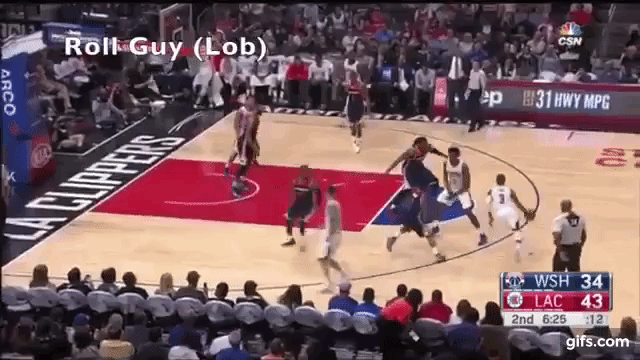
“Popping”
Popping the the yin to the dive’s yang. Instead of rushing to the hoop, the screener “pops” back or sideways into open space.
The pick and pop is deadly weapon because the geometry of it makes it so hard to guard. If the screener is a shooting threat, he is going to immediately move to the shooting space away from the ball handler and put a ton of pressure on his defender to help and then make a long recover. Not much explanation needed here, just a quick clip of the King of Pick and Pop.
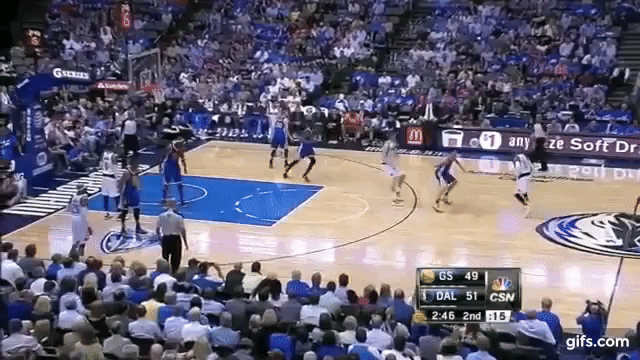
“Short Rolling”
The “short roll” lives between the dive and the pop. Depending on the coverage, the roll man in the PNR may find the that the intermediate space between the rim and the three point line (AKA the mid-range, BAD WORD!) is the best space to operate.
For example, if a team is aggressive with it’s PNR defense and hedges hard or blitzes, the screener won’t want to dive all the way to the rim because he’s to far out of the play and popping is too close. In that case, moving towards the hoop under control, instead of racing all the way to the rim, can create a 4-on-3.
It’s sort of like a tiny press break. If the ball handler can make a pass out the trap to the middle of the floor, the offense can attack the advantage. Good passing and ball handling big are incredibly effective in this space. Draymond Green is the prototypical short roller.

“Gravity”
Gravity is new fancy way of saying “He’s really good at putting the ball in the basket, you have stand close to him when he’s on the court. Maybe even put a few guys near him.” A player’s offensive talent is the source of his gravity and his mere presence can bend the defense in a particular way.
Gravity can apply to all five players on the court. Isaiah Thomas’s ability to shoot from behind a screen pulls defenders towards him, but Al Horford’s ability to pop out and make a three does the same. Klay Thompson’s shooting stroke means defenders want to stick near him and may not help the helper. Gravity creates space for the pick-and-roll to work.
The Golden State Warriors have more gravity than a black hole. Close to it, at least.
That’s all for now! We may keep adding to the glossary as the season progresses but in the meantime feel free to ask me questions in the comment section or add your own thoughts to The Whiteboard. Drop a comment below if there’s a topic you’d like covered in the future.
bob
.
THE CELTICSHUB WHITEBOARD: PICK AND ROLL GLOSSARY
By Ryan Mahanna
On September 7, 2017
The Whiteboard is back after a short hiatus (there has been some actual Celtics news over the past few weeks, ICYMI) and we are ready to talk some basketball. If this is your first peek at The Whiteboard, welcome! We are here to help fans understand the game a little bit better and feel more informed when they are watching their favorite team, which of course is the Celtics.
Today’s topic is the pick and roll, a staple of the game’s past and present and a bedrock of basketball. Although it may seem like NBA teams run a pick and roll (we’ll call is PNR for short) every time down the floor, according to Synergy Sports, PNRs only make up about 17% of plays. The Celtics fall below that average (the Warriors are the lowest, which makes you really think) but it’s still a play that casual fans should be familiar with and, although it might be the simplest play in sports, it has its own unique language.
Below are some of the buzz words and phrases that you may hear during a NBA telecast. Hopefully these definitions and GIFs help prepare you for the upcoming season and at the very least help you to sound smarter than your friends.
Defense
“Help the Helper”
This term has a literal meaning, help your teammate who is helping someone else. Nothing kills a team defense like not helping the helper. Because guess what? The helper stops helping. He’s not going to leave his man to help you if he thinks no one else has his back. This is more of a general defensive term but it’s key to defending pick and rolls. Here is Kawhi Leonard stepping in and helping the helper.

“Hedging” or “Showing”
These terms are basically interchangeable. The secondary defender (i.e. the man guarding the screener) will position himself up to the level of the ball so he can step out and impede the progress of the ball handler. The hope is that the hedging defender can cut off the direct driving line and give his teammate time to recover. Once the primary defender has recovered to his man, the secondary defender hustles to recover back to his. Celtics fans should be familiar with this action from the KG era.

That was a basic one-step hedge and recover; a “soft” hedge. When the second defender takes two or three steps out to impede the ball handler, that is a “hard” hedge. In this case the man defending the screener is taking on a more agressive roll in chasing the ball handler off the direct path to the rim.

In both instances, you are asking the man defending the screener to be a good communicator, agile and well conditioned. Since those aren’t attributes that you’d typically associate with a big man, this type of pick and roll defense can be tricky. The entire 5-man defensive unit has to be working together.
“Blitzing” or “Jumping”
These terms are the extreme cousins of hedge/show. These are essentially fancy terms for trapping a PNR. Both defenders sell out and try to get the ball handler to pick up his dribble and make a bad decision. This is an effective technique late in the shot clock or if you simply want to get the ball out of a particular player’s hands.

“Ice”
Icing a ball screen is modern technique that has an awesome name but is actually very simple. Icing’s patron saint is Tom Thibodeau and the simplicity is part of the genius.
After orchestrating a decade’s worth of elaborate hedge/help/recover defensive schemes, Thibs decided to boil things down to some basics:
1. Don’t let the ball get to the middle of the court
2. Force the ball handler to take a mid-range shot
2. Avoid having to help, and the chaos that follows
If you’re not going to help, that means you have to defend the ball screen two on two. The easiest way to defend a PNR is to prevent the screen from happening in the first place.
To do that, the on-ball defender angles his body so his man has no choice but to go away from the screen. Dribbling off the screen is no longer a option, but by doing that you are creating a wide open driving lane. The on-ball defender is pushing the ball handler into the midrange and along the sideline. The player defending the screener drops back to protect the paint.
A GIF is worth a 1000 words:

Notice how Batum angles his body to push the ball down the sideline and Lopez drops to protect the rim, classic ICE! This coverage keeps big men in their comfort zones, creates a one-branch decision tree for the ball handler, and prevents rotation breakdowns. Icing would be incredible at the lower levels of the game. If you coach a J.V. basketball team, put it in and tweet me updates.
Offense
“Pocket Pass”
Such a good name! The pocket pass is a type of pass that is commonly used in a PNR to hit the roll man in a tight window before the defense can recover. The pass is delivered on the bounce and originates from the ball handlers waist/hip area, therefore the “pocket.” Here is the master, Steve Nash, in action.

“Slip” or “Slide”
Slipping is an action that a screener can take to keep the defense on it’s toes. It is essentially a fake screen. The screen setter is using change of pace and change of direction to “slip” free.
The key is to approach the ball handler as if you were going to set a traditional screen. Your feet should be set and you should have no body movement. The moment you get the defense to settle into a plan, the screener will quickly move away from the ball and look for open space. The screen is actually never set and the hope is to catch the defense flat-footed or ready to begin a pre-planned coverage.
There is no wrong way to slip a screen and it’s very effective against switching defenses. You can slip for a jump shot, which is sometimes referred to as a “slide.”

Or slip to the rim, Karl Malone style.

Slipping ball screens is especially effective against switching defenses. If you time it right, you can break free right at the moment when they were going to switch and find yourself wide open. Ultimately, it is a change of pace attack.
“Denying” or “Rejecting”
Denying a ball screen is very simple. The ball handler acts like he is going to come off the screen to attack but instead he goes the complete opposite way. You always want to keep the defense honest and denying the ball screen is a great way to catch them sleep walking. Here’s our new friend Kyrie Irving in action

“Splitting”
When the ball handler “splits” the ball screen it means that he is taking advantage of a hard hedge (see above) and using the dribble to make overzealous defenders pay. He will squeak through a gap between the defenders and come out of the other side with a numbers advantage. It’s super fun. Kyrie is incredible at these; it was hard to pick one.

“Diving”
One could argue that “diving” has replaced the roll in pick and roll. For decades, players have been taught to roll and certain way. Set a good solid pick, wide base, let the ball handler come tight off your shoulder, give it a count and then open up to the ball as if you were screen door that was pushed open.
A “dive” isn’t as formal. Try to set a good clean screen, but most importantly explode down the lane as quickly as possible, footwork be damned. The whole goal is force the defense to have to react to the threat of a lob as quickly as possible. This opens up three point shooters because, of course, they are helping the helper. Think Deandre Jordan.

“Popping”
Popping the the yin to the dive’s yang. Instead of rushing to the hoop, the screener “pops” back or sideways into open space.
The pick and pop is deadly weapon because the geometry of it makes it so hard to guard. If the screener is a shooting threat, he is going to immediately move to the shooting space away from the ball handler and put a ton of pressure on his defender to help and then make a long recover. Not much explanation needed here, just a quick clip of the King of Pick and Pop.

“Short Rolling”
The “short roll” lives between the dive and the pop. Depending on the coverage, the roll man in the PNR may find the that the intermediate space between the rim and the three point line (AKA the mid-range, BAD WORD!) is the best space to operate.
For example, if a team is aggressive with it’s PNR defense and hedges hard or blitzes, the screener won’t want to dive all the way to the rim because he’s to far out of the play and popping is too close. In that case, moving towards the hoop under control, instead of racing all the way to the rim, can create a 4-on-3.
It’s sort of like a tiny press break. If the ball handler can make a pass out the trap to the middle of the floor, the offense can attack the advantage. Good passing and ball handling big are incredibly effective in this space. Draymond Green is the prototypical short roller.

“Gravity”
Gravity is new fancy way of saying “He’s really good at putting the ball in the basket, you have stand close to him when he’s on the court. Maybe even put a few guys near him.” A player’s offensive talent is the source of his gravity and his mere presence can bend the defense in a particular way.
Gravity can apply to all five players on the court. Isaiah Thomas’s ability to shoot from behind a screen pulls defenders towards him, but Al Horford’s ability to pop out and make a three does the same. Klay Thompson’s shooting stroke means defenders want to stick near him and may not help the helper. Gravity creates space for the pick-and-roll to work.
The Golden State Warriors have more gravity than a black hole. Close to it, at least.
That’s all for now! We may keep adding to the glossary as the season progresses but in the meantime feel free to ask me questions in the comment section or add your own thoughts to The Whiteboard. Drop a comment below if there’s a topic you’d like covered in the future.
bob
.

bobheckler- Posts : 61564
Join date : 2009-10-28
 Similar topics
Similar topics» Assessing The Celtics' Pick-and-Roll Defense
» Practice Notes: Pick-and-Roll the Focus
» Red and Larry on how to execute a pick and roll and the options it allows
» Assessing The Celtics' Pick-and-Roll Defense, Part I
» How The Celtics Are Utilizing The Pick-and-Roll as Ball Handlers
» Practice Notes: Pick-and-Roll the Focus
» Red and Larry on how to execute a pick and roll and the options it allows
» Assessing The Celtics' Pick-and-Roll Defense, Part I
» How The Celtics Are Utilizing The Pick-and-Roll as Ball Handlers
Page 1 of 1
Permissions in this forum:
You cannot reply to topics in this forum|
|
|
